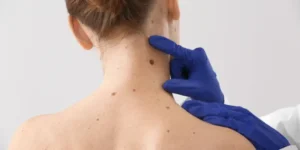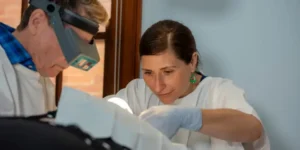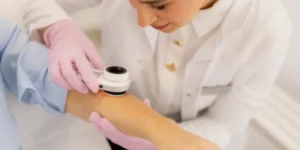Melanoma Check: Skin Cancer Screening Tips with Skin Cancer Hub
Worried about a strange mole or spot on your skin? Skin cancer, including melanoma, is common but dangerous if not caught early. This guide will explain how to do a proper melanoma check and what signs to look for.
Keep reading—it could save your life.
Key Takeaways
- Check your skin monthly for unusual moles or spots. Use the ABCDE guide to identify warning signs such as asymmetry, irregular borders, multiple colours, large size, or any changes over time.
- Melanoma is the most serious form of skin cancer but is treatable if detected early. Early-stage detection offers a 99% survival rate compared to only 35% if it spreads further.
- Cancer Council offers free screenings through initiatives such as Destination Healthy Skin. In 2025, they identified 86 melanomas out of 1,009 potential cases during 2,439 checks.
- Protect your skin by applying SPF 30+ sunscreen every two hours and wearing protective clothing. Minimise exposure to strong sunlight between 10 am and 4 pm.
- Annual professional skin exams assist in monitoring mole changes over time using tools such as dermoscopy and total body photography for precise tracking.
Signs and Symptoms of Skin Cancer

Observe any new areas or alterations in the size, shape, or colour of moles. Keep an eye out for irregular edges, varied colours, or elevated sections.
Be mindful of sensations like itching, tingling, bleeding, or textured skin on a mole. Certain melanomas can present as pink, red, white, or translucent.
How to Perform a Skin Self-Examination
Checking your skin regularly can help find early signs of skin cancer. Follow these steps for an effective self-exam:
- Undress completely to see all areas of your skin.
- Stand in a well-lit room for better visibility.
- Use a full-length mirror to check your entire body.
- Hold a hand mirror for hard-to-see places like your back or behind the ears.
- Ask someone you trust to help with spots you cannot view, like your scalp or lower back.
- Look closely at soles of feet, between toes, and under nails for changes or new marks.
- Check the spaces between fingers and toes thoroughly.
- Keep track of any moles, freckles, or patches that seem unusual.
- Repeat this process every month to spot issues quickly.
Knowing your skin helps catch concerns early during these checks!https://www.youtube.com/watch?v=UnCUcFJJDSA
The ABCDEs of Melanoma Detection
Spotting melanoma early can save lives. The ABCDEs method assists in identifying warning signs of skin cancer promptly.
- Asymmetry – Observe uneven shapes. One half of the spot may differ from the other.
- Border – Examine edges. Irregular or jagged borders could indicate an issue.
- Colour – Pay attention to multiple colours within one mole, such as black, red, or blue.
- Diameter – Check the size. If it is greater than 6 mm or increasing, take notice.
- Evolving – Observe any changes in size, shape, colour, or texture over time.
Compare moles to identify a mark that stands out distinctly from others in its vicinity.https://www.youtube.com/watch?v=iiXfaX2wDxU
Types of Skin Cancer
Melanoma is the deadliest type. It can spread if not treated early. Nodular melanoma grows quickly, appears firm, raised, and dome-shaped. Sometimes it bleeds or crusts.
Basal cell carcinoma is the most common but least dangerous. It grows slowly and looks red, pale, or pearly. Squamous cell carcinoma often shows as thickened, red, scaly patches that may crust—common in people over 50 years old.
Acral lentiginous melanoma affects palms, soles, or areas under nails and is more frequent in people of colour.
When to Consult a Professional
New or unusual skin growths need attention. A General Practitioner (GP) can check these changes early. If a mole appears after 25, make an appointment.
Annual skin checks help with early melanoma detection. Tools like dermoscopy and digital monitoring provide clear images of any change. Total body photography is useful for tracking moles over time.
See a professional if signs suggest cancer has spread to lymph nodes. Early treatment improves survival rates—99% for detected cases in the first stage but drops to 74% with lymph node involvement and only 35% when it spreads further.
Melanoma Checks with Skin Cancer Hub
The Skin Cancer Hub in Brisbane provides expert support for melanoma detection. This clinic at 61 Ipswich Rd, Woolloongabba is equipped with advanced tools for diagnosis and treatment—no referral required.
It aims to increase awareness and provide timely care.
Supplementary tips for Skin Cancer Screening
Regular skin checks are key to spotting changes early. Protecting your skin and tracking spots can lower risks of skin cancer.
Using Skin Check Apps
Skin check apps help with mole comparison and melanoma detection. These tools allow skin health tracking over time, making it easier to spot changes early. Digital monitoring can highlight the “Ugly Duckling” sign—moles that look different from others.
Apps also assist with lesion examination and skin irregularity assessment. They provide reminders for dermatological monitoring and mole scrutiny. Regular updates improve your skin cancer surveillance without needing immediate professional visits.
Protecting Your Skin from Sun Damage
Limit time in the sun, especially between 10 am and 4 pm. UV rays are strongest during these hours and can cause skin damage quickly. Use a broad-spectrum sunscreen with SPF 30 or higher.
Apply it generously every two hours or after sweating or swimming.
Wear protective clothing like long sleeves, hats, and sunglasses. Lightly woven fabrics might not block UV rays fully, so opt for tightly woven materials if possible. Shade is your best friend—use umbrellas or stay under trees to reduce direct exposure.
-Regular Professional Skin Checks-
Regular Professional Skin Checks
Professional skin exams should be done once a year or more often if needed. General practitioners, dermatologists, or clinics specialising in skin cancer can perform these checks.
Regular mole inspections help find changes early. Ongoing skin examinations make sure suspicious spots are reviewed. Frequent screenings lower the risk of missed signs by ensuring consistent monitoring over time.
The ABCDEs of Melanoma Checks and Other Warning Signs
When you check your skin regularly, you increase the chances of identifying warning signs early. A routine skin check can help detect melanoma and other issues before they progress. This article is worth reading because it explains how to look for changes, what the ABCDES of melanoma stand for, and why it’s so important to seek professional skin advice if you notice any signs of trouble.
Why Monitor Your Skin and Make an Appointment?
It’s crucial to monitor your skin on a consistent basis, looking for any new spot or existing mole that seems to evolve. Scheduling a skin cancer check at a skin cancer clinic can help diagnose skin cancer in an early stage, improving outcomes if cancer is found. If you find a new mole, watch for colour or size changes and notice any changes over time.
How to Identify a Mole or Freckle That Needs Attention
A mole or freckle may be concerning if it appears different from your normal skin. Compare any mole or freckle to the ABCDE criteria:
- A (Asymmetry): Does it lack symmetry?
- B (Border): Are the edges uneven or blurred?
- C (Color): Is it brown or black, or a mix of colors?
- D (Diameter): Is it larger than a pencil eraser?
- E (Evolving): Are you seeing changes to existing spots?
Why Are Early Signs So Important?
Early signs of melanoma may include a new spot that looks unusual or a changes to existing mole. Melanoma is often aggressive, but melanoma usually stands out compared to other skin conditions. Seeking help to prevent skin cancer is key, as melanoma may spread quickly.
What Is the Role of the Cancer Council NSW?
The cancer council nsw supports cancer research and promotes awareness to reduce your risk of developing melanoma. According to the cancer council’s guidelines, sun protection measures like wearing a hat and sunscreen can greatly reduce your risk.
How Does Sun Protection Help?
Using sun protection such as sunglasses, clothing, and sunscreen can prevent skin cancer and lower your risk of developing melanoma or other forms. Including skin checks in your routine further enhances your chances of finding problems early.
Which Skin Cancer Types Should You Look For?
Besides melanoma, there are basal cell carcinoma and squamous cell carcinoma. A brown or black spot that appears suddenly or changes rapidly may indicate including nodular melanoma. Doctor may need a biopsy to confirm.
When to See Your Doctor
If you find skin spots that concern you, see your doctor for a full skin evaluation. Melanoma institute australia research shows that melanoma found early is more treatable. Make sure to photograph your skin if needed, or ask a friend to check areas you can’t see yourself.
Why a Skin Clinic Is Essential
A skin cancer clinic offers thorough exams, using specialized equipment and expertise. This ensures a better chance to diagnose skin cancer early. Important to get professional input if you suspect any warning signs.
Why Checking Your Skin Regularly Matters
By checking your skin for new or changing spots, you improve your odds of catching issues in time. Even the smallest anomalies can grow worse if overlooked.
Comparison Table: Common Skin Cancers
| Type | Appearance | Growth Rate |
|---|---|---|
| Melanoma | Can be dark or multicolored | Often Rapid |
| Basal Cell Carcinoma | Pearly bump or pink lesion | Slower |
| Squamous Cell Carcinoma | Scaly patch or crusty bump | Moderate |
Key Takeaways:
- Conduct regular self-checks to catch any new spot early.
- Monitor your skin using the ABCDE criteria.
- Sun protection is vital to prevent skin cancer.
- Look out for changes to existing moles or any concerning skin spots.
- Make sure to make an appointment with a professional for an in-depth check.
Conclusion
Checking your skin can be lifesaving. Monitor any changes, spots, or moles that appear unusual. Utilise resources like the ABCDE guide and apps to keep track of skin health. Consult professionals if you are uncertain about a spot.
Acting early is crucial to avoiding significant risks.
For more detailed information on melanoma checks and how to book an appointment, visit Skin Cancer Hub’s Booking page.
FAQs
1. What is melanoma, and why is early detection important?
Melanoma is a dangerous form of skin cancer that can spread quickly. Early detection improves treatment success and survival rates.
2. How can I check for signs of melanoma at home?
Look for changes in moles or spots—size, shape, colour, or edges. Watch for new growths or sores that don’t heal.
3. Why should I consider professional skin cancer screening?
Doctors use advanced tools to spot cancers you might miss. Regular checks with Cancer Council NSW’s guidance ensure thorough monitoring.
4. What are some tips to reduce my risk of melanoma?
Wear sunscreen daily, avoid too much sun exposure, cover up outdoors, and stay alert for any unusual skin changes over time.





